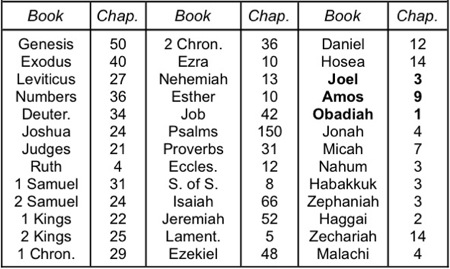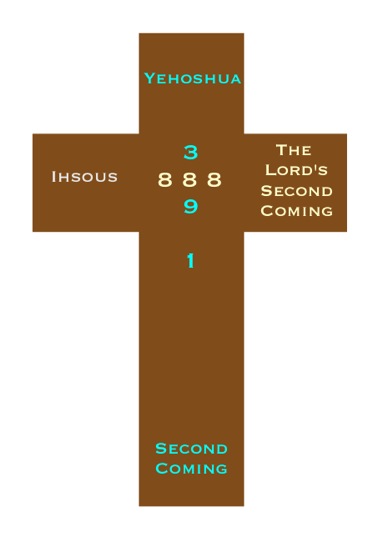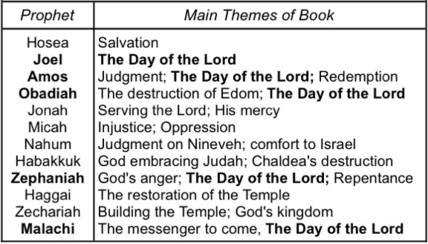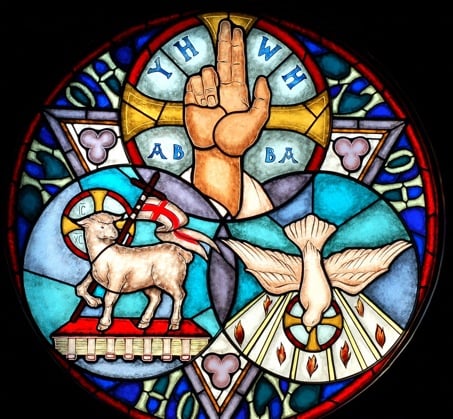The Sign of the Cross
Introduction
The Sign of the Cross is a ritual crossing motion made by the hands, practiced in the Roman Catholic and Orthodox traditions. It represents the cross on which our Lord was crucified and is accompanied by the words ‘In the name of the Father, the Son and the Holy Spirit. Amen’. The Sign is a blessing, to be made before and after prayers, in the presence of the sacraments, when passing a church, during times of trouble or temptation and on other occasions.
The NIV Bible contains its own ‘sign of the cross’, a crossing of two numbers that are built into the foundations of God’s Word and which therefore form something more permanent than any man-made structure. [1] The centrepoint of this cross marks the site of a major end-time prophecy and the numbers forming the stake and crossbeam mark, and are part of, a cluster of encoded numbers at this location. These numbers link the prophesy to two momentous occasions when God chose to intervene in human affairs and change the course of history.
The Stake
One day, whilst looking through my old KJV Bible, I noticed an unusual sequence of numbers in an index of the books of the Old and New Testaments. The index lists each book and the number of chapters in that book. Looking down the list I soon spotted the three digits of a familiar number, 391, these digits being the number of chapters in three successive books near the end of the Old Testament. Here is that list, with the relevant numbers highlighted.
The Books Of The Old Testament

Note that the number is associated with the books of Joel, Amos and Obadiah. The sum of the standard values of the English names of these prophets again suggests that this spot may be marked for our attention.
Joel + Amos + Obadiah (s) = 391
What I had found so far could, of course, be coincidence. However, since I was already aware of the importance of the number 391, I decided to investigate further.
The Number 391
The evidence amassed in the preceding pages on this website confirm 391 is one of the key numbers in the New Bible Code, because it is the standard value of the Hebrew word for Jesus, transliterated as Yehoshua, and also because it is the standard value of the English phrase 'Second Coming'. [2]
Second Coming (s) ..= 391
The number is encoded within the opening words of the NIV, as part of a suite of encoded signatures of Christ. It is also encoded within the closing words of the NIV Bible and elsewhere. Both this page and those that follow confirm the importance of 391 in unlocking the meaning conveyed by the code.
Lets turn to the crossbeam.
The Crossbeam.
After discovering the encoded 391, I calculated the positional value within the Bible of the last chapter of each of these three books (chapters 3, 9 and 1) and discovered that the placing and number of chapters in these books was no coincidence. Here are the three books, along with their number of chapters and the positional value of each final chapter.
Joel, Amos and Obadiah: Chapters And Positional Values

As you can see, the 9th chapter of Amos is the 888th chapter in the Old Testament. So at this location, 888 'crosses' 391. The number 888 is also one we have encountered in previous pages.
The Number 888
Like 391, 888 has already shown itself to be a key number within the New Bible Code, as it is the standard value of the Greek word for Jesus, transliterated as Ihsous, and the English phrase 'The Lord's Second Coming'.
![]()
The Lord's Second Coming (s) ......= 888
This link to the word ‘Jesus’ as it is spelled in the Hebrew and Greek languages also reflects the Hebrew and Greek origins of the Bible - which is surely a further sign of deliberate intent!
888 features prominently in encodings found at the beginning of the NIV Bible. The number is also encoded over the first and last verses of the NIV, one of three signatures that form a kind of seal on this version, and elsewhere. Again as with 391, the importance of 888 in unlocking the meaning conveyed by the code cannot be overstated.
The Cross
These two key numbers, profoundly linked to Jesus Christ through gematria, form a symbolic cross within the 66-book protestant Bible. The centrepoint of this cross lies at Amos 9, the 888th chapter of the Bible, with the number 391 forming the stake and 888 forming the crossbeam.
Here then is the Sign of the Cross.
The Sign of the Cross....

Crosses are used to mark the location of something important (“X marks the spot.”) Is there any reason why this particular location would be marked with a cross and two numbers signifying the Second Coming? First of all recall that in biblical numerics nine is the number of endings, finality, judgment, fruits and suffering. This sets the tone for what is to follow.
Joel, Amos, Obadiah and the Day of the Lord
Joel, Amos and Obadiah were three of the twelve so-called minor prophets, whose writings form the last twelve books of the Old Testament (the use of the adjective ‘minor’ is not to be taken as an indication of their importance, but of the brevity of their writings). A summary of the minor prophets (listed in biblical order) and the main themes they address in their writings is tabulated below. [3]
The Minor Prophets and Their Writings

Notice the highlighted theme: the day of the Lord. This is a time when God’s wrath is poured out on a people for their sins, and it can refer to local judgments made on individual nations during biblical times. However, the Bible repeatedly insists that God will intervene in human affairs one last time, calling all nations to a final judgment. This final ‘day of the Lord’ will be one of terrible retribution. For example, Joel and Malachi have this to say:
The sun will be turned to darkness and the moon to blood before the coming of the great and dreadful day of the Lord. (Joel 2.31, NIV)
“Surely the day is coming; it will burn like a furnace. All the arrogant and every evildoer will be stubble, and that day that is coming will set them on fire,” says the Lord Almighty. “Not a root or a branch will be left to them.” (Malachi 4.1, NIV)
Of the other nine minor prophets, only three use this phrase. Of the major prophets, only Isaiah and Ezekiel mention it. However, when we read Joel, Amos and Obadiah, the books at the stake of the cross, we see that the day of the Lord is a major concern of each book. In fact, of the eighteen Old Testament mentions of the phrase ‘day of the Lord’, no less than nine are found within these three successive books. [4]
My investigations had so far uncovered two numbers which happen to be the standard values of the Hebrew and Greek words for Jesus ‘crossing’ in the middle of a cluster of prophecies of the ‘day of the Lord’. It was now time to take a closer look at the centrepoint of the cross, Amos 9.
Amos 9 and the Cross
Although I knew that the numerical cross centred at Amos 9 is found in every 66-book Bible, I suspected that the NIV, as the vehicle for the New Bible Code, might contain further encoded numbers within the text. The chapter begins with these dramatic words:
I saw the Lord standing by the altar, and he said: “Strike the tops of the pillars so that the thresholds shake. Bring them down on the heads of all the people; those who are left I will kill with the sword. Not one will get away, none will escape.” (Amos 9.1, NIV)
Amos is sometimes called the prophet of doom and his book begins with God’s condemnation both of Israel’s neighbours and of Israel itself. The book nears its close with a series of five visions of God’s judgment on Israel. Amos 9:1-6 contains the last and most terrible of these: a picture of Israel’s destruction. The book also makes clear that this punishment is inevitable. The cross, therefore, marks the exact site of one of the Bible’s most important eschatological prophecies: the almost total destruction of Israel on the Day of the Lord.
On checking for encoded numbers within the text I soon found that my hunch about the importance of this location was correct, because the word 'cross' and its Hebrew equivalent, Tav, are encoded over the first two groups of nine words.

So the first and second group of nine words in the ninth chapter of Amos, the very spot marked by an encoded numerical cross, encode the English and Hebrew words for cross! These encodings conflate the idea of cross with the number 9, the biblical meaning of which is endings, finality, judgment, fruits and suffering. As well as being the Hebrew word for 'cross', Tav is also the name for the final character of the Hebrew alphabet, which again suggests endings and finality. [5] Note that we see two related concepts encoded within adjacent strings and that the strings are of equal word length. These features suggest design rather than chance.
Amos 9 and The Crucifixion
The reason why the cross is the symbol of Christianity is, of course, because Jesus of Nazareth was crucified on one. Jesus was crucified along with two robbers, one on either side of Him:
Two robbers were crucified with him, one on his right and one on his left. (Matt. 27.38 NIV)
1. The first twenty-four words of Amos 9 encodes two references to the crucifixion of all three men.

The phrase ‘two robbers’ is found twice, in Matthew and Mark. Luke has ‘two criminals’ and John describes them as ‘two men’. Therefore the gematria of the phrase ‘two robbers’ is more significant within this context than that of the other two phrases. Additionally, the phrase 'two robbers' is also found first, and the first instance of any idea in the Bible is of prime importance.
There are more encoded numbers within the text here that relate this prophecy to the Crucifixion. Twenty-four is the reduced value of Ihsous, 'word' and 'holy', is associated with heavenly government and features in the six signatures of Christ found at the start of the NIV Bible. The digits 11 and 9 in 1109 also suggest 9/11.
2. The ordinal value of the entire first verse encodes the same information as the first 24 words.
I saw the Lord standing by the altar, and he said: “Strike the tops of the pillars so that the thresholds shake. Bring them down on the heads of all the people; those who are left I will kill with the sword. Not one will get away, none will escape.” (Amos 9:1, NIV)

Here we see the crucifixion itself - indeed the crucifixion of all three men on that day - being repeatedly brought to our attention by another pair of encoded numbers, each expressing the same two concepts. So the cross at Amos 9 connects the Day of the Lord to the crucifixion of Jesus Christ, with the two crucified robbers also brought to our attention. The cross numbers, 391 amd 888, link both of them to Jesus' Second Coming.
Note that all of these word strings, apart from Tav, begin on the first word of the verse. Numerating a word string that begins from a fixed point, rather than a string that could begin anywhere in a passage gives a greatly reduced chance of randomly hitting any given numbers and therefore a greatly increased chance that these phenomena are the product of intelligent design, rather than random action. [6] Given the 9/11-related numbers already found within that same portion of text, this again looks like design. [7]
Amos 9 and 9/11
Lets look again at the first, crucial verse of Amos’ prophecy.
I saw the Lord standing by the altar, and he said: “Strike the tops of the pillars so that the thresholds shake. Bring them down on the heads of all the people; those who are left I will kill with the sword. Not one will get away, none will escape.” (Amos 9.1, NIV)
These words resonate very strongly with a modern event: the terrorist attacks on the twin towers on September the 11th, 2001.
The theme of the tops of pillars being struck, then falling down on “the heads of all the people”, almost perfectly mirrors the events of attacks of that day: the towers were both struck near their top storeys and subsequently collapsed, killing almost three thousand people.
This interpretation is strongly reinforced through yet more encoded numbers, this time beginning with the words of the Lord: "Strike the tops of the pillars . . ." Although not the first words of the verse, they are an important clause within it and so again it an indicator of design that this group of encoded numbers begins there.

The verses also encode numbers. Amos 9:1 is the 132nd verse in Amos, 132 being 11 x 12. In addition, the first place the phrase ‘day of the Lord’ is mentioned by Amos (as I said, Amos is thought to be the originator of the phrase) is Amos 5:18. This is the 77th verse in Amos, 77 also being a multiple of 11. So both verses are marked with the number 11, as was 9/11 itself.
9/11 and the Day of the Lord
The Garden is the name I have given to the first five verses of the NIV Bible, encoded with numbers that summarise the entire New Bible Code. On checking for evidence linking 9/11 to the Day of the Lord, I found the following three word strings:

Here is a second table, showing the same information in the same location and linking it to the Lord Himself, Jesus Christ.

Notice how neatly these word blocks line up and how 'The Incarnation' bookends the entire set. These encodings confirm that the events of September-11, 2001, are to be seen as the prophesied the Day of the Lord and that this day and the day of the Lord's return are one and the same event.
Summary
The encoded numerical cross I found as I perused the index of my old KJV Bible was placed there to mark the precise location of a suite of numbers encoded within the modern NIV Bible as part of the New Bible Code. These appear to have several functions:
1. To highlight a major prophecy of the Day of the Lord, a day at the ‘end of history’ when God intervenes in human affairs to render a solemn judgment on the behaviour of humankind, represented by Israel in the prophecy.
2. To set the overall theme for this encoding through the number 9 - signifying endings, judgment, finality, fruits and suffering - found as the chapter number, as the word count of several of the encoded word strings, and featuring in the numbers 91, 911 and 1109. This and many other prophecies have prepared us for the inevitable fact, that, due to man’s sinful behaviour, ‘That day will be darkness, not light’ (Amos 5:18).
3. To relate the day of the Lord to the Crucifixion, through the encoding of a numerical ‘cross’ within the structural features of the 66-book Bible, through the encoding of the words ‘cross’ and ‘Tav’ (cross), through repeated pairings of related concepts (akin to crossing) and through the encoding of the standard values of Jesus Christ and the two robbers.
4. To relate the day of the Lord and the Crucifixion to a third modern event, September the 11th, 2001, through the first verse of the prophecy - where “the tops of the pillars” are struck, bringing them down “on the heads of all the people” - through the encoding of the numbers 11, 911 and 1109. The ‘Sign of the Cross’ within the NIV Bible reveals that God chose to intervene in human affairs on September the 11th, 2001. On that terrifying, unforgettable day God's wrath was emptied out on the World Trade Centre and the Pentagon - in a symbolic, but also very real crucifixion.
5. To add its voice to the announcement of the Second Coming of Jesus Christ, which is the purpose of the New Bible Code.
Bill Downie 23/5/09
Revised 21/11/23
Notes
1. All modern 66-book bibles contain the numerical cross. However, as you will see, the NIV appears to be the version for which the cross was encoded.
2. Other versions of the word, such as ‘Yeshua’ , sre also found in the Hebrew Bible, but ‘Yehoshua’ is very commonly used and is the word translated in the Septuagint as ‘Ihsous’, which became ‘Jesus’ in modern English.
3. This table is adapted from one found at http://www.biblestudy.org/prophecy/minor-prophets.html
4. There are six mentions of the phrase in the New Testament, making twenty-four biblical mentions in total.
5. Tav also means ‘mark’. The meaning of this character in Jewish mystical thought is worthy of study.
6. To understand this fact, imagine creating strings of ten words from a sentence of twenty words. These would be words 1 to 10, 2 to 11, 3 to 12, and so on up to words 11 to 20. Eleven such strings could be created, multiplying by 11 the chances of randomly hitting a particular number, compared to the practice of only numerating the first (or last) ten words.
7. The average ordinal value for a portion of text in the NIV is about 50, so there is a 1-in-50 chance of hitting any particular number. The chances of hitting two numbers is 1 in (50 x 50) or 1 in 2500.
8. I suggest you study The Signature of Christ for comparison.
